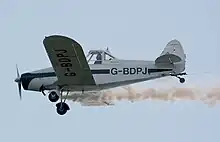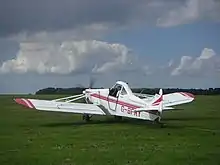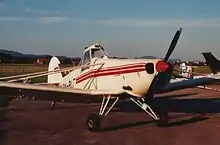Piper PA-25 Pawnee
The PA-25 Pawnee is an agricultural aircraft produced by Piper Aircraft between 1959 and 1981. It remains a widely used aircraft in agricultural spraying and is also used as a tow plane, or tug, for launching gliders or for towing banners. In 1988, the design rights and support responsibility were sold to Latino Americana de Aviación of Argentina.
| PA-25 Pawnee | |
|---|---|
 | |
| PA-25 Pawnee | |
| Role | Agricultural aircraft Towplane |
| National origin | United States |
| Manufacturer | Piper Aircraft |
| Designer | Fred Weick |
| First flight | 1957 |
| Introduction | August 1959 |
| Produced | 1959-1981 |
| Number built | 5,167 |
Design and development
Most agricultural aircraft before 1949 were converted military aircraft and it was in that year that Fred Weick, based at Texas A&M University, designed a dedicated agricultural aircraft: the AG-1. The AG-1 first flew on 1 December 1950.[1]
During 1953, Fred Weick was approached by Piper to become a consultant on the agricultural version of the PA-18, the PA-18A, in particular to design and test a distributor for dust and seeds.[1] A few weeks later, Piper sponsored Texas A&M University to design a dedicated agricultural aircraft based on the AG-1 but to use as many PA-18A and PA-22 components as possible. The resulting design, the AG-3, was smaller than the AG-1 and had a steel tube fuselage which was fabric covered.[1] The AG-3 was a single-seat, low-wing monoplane with the wings braced to the fuselage with struts. It had a conventional landing gear with a tailwheel and was powered by a 135 hp engine.[1] The single seat was placed high in the fuselage to give the best visibility and an 800 lb-capacity hopper was fitted in front of the cockpit.[1]
The AG-3 made its maiden flight in November 1954.[2] The aircraft's flying tests were successful and, in 1957, Weick was invited to join Piper at Vero Beach, and the AG-3 was renamed the PA-25 Pawnee. The engine was upgraded to a 150 hp Lycoming O-320-A1A engine.[1] Two pre-production aircraft were built at Vero Beach in 1957 and production started at Lock Haven, Pennsylvania, in May 1959.[1]
In 1962, another prototype was built at Vero Beach with a 235 hp Lycoming O-540-B2B5 engine and production aircraft were produced at Lock Haven from 1962.[1] In 1964, the Pawnee B was introduced with a larger hopper and improved dispersal gear. The Pawnee C of 1967 was fitted with oleo shock-absorbers and other improvements; also in 1967, a 260 hp variant was introduced.[1]
Early models of the Pawnee had a single fuel tank located between the agricultural hopper and the engine. The National Transportation Safety Board recommended to Piper Aircraft that the early model PA-25's with a fiberglass fuel tank be retrofitted with a rubber fuel cell to minimize the chance of catastrophic failure and fire resulting from a crash.[3]
In 1974, the Pawnee D was introduced, with the fuel tanks moved from the fuselage to the wings; the 260 hp variant was also available with either a fixed pitch or constant-speed propeller.[1] Although still the same design as the "D", the 1980 and 1981 production aircraft were marketed as the Pawnee.[1] The final production aircraft was completed at Lock Haven on 22 March 1981, the last of 5,167 Pawnees.[1]
A useful design aspect was the ability to carry a mechanic on a jump seat fitted in the hopper to assist with operations at remote stations.[4]
On April 15, 1988, Piper Aircraft, Inc. officially sold the PA-25 series aircraft to Latino Americana de Aviación S.A in Argentina. The sale included all drawings, engineering data, parts inventory, tools, catalogs, and manuals. All support of any nature became the responsibility of the new owners.[5]
In 2019, Australia's Civil Aviation Safety Authority formally approved the issuing to eTugs of Certificates of Airworthiness in the Limited category for the purpose of glider towing. An etug is a PA-25 where the Lycoming engine has been replaced with a General Motors LS automotive engine. The advantages for glider towing, compared to a Lycoming powered PA-25, include a greater rate of climb, reduced fuel consumption, the elimination of shock cooling (since the LS is water-cooled rather than air-cooled) and a less costly maintenance regime.[6][7]
Variants
- AG-3
- Prototype built at Texas A&M University.
- PA-25-150 Pawnee
- Initial production version fitted with a 150 hp (110 kW) Lycoming O-320 engine. Payload of 800 lb (360 kg) powders or 145 US gal (121 imp gal; 550 L) liquids.[8]


- PA-25-235 Pawnee B
- Fitted with a 235 hp (175 kW) Lycoming O-540-B2B5 six-cylinder engine. The Pawnee B featured a larger hopper and an increased payload of 1,200 lb (540 kg).[9]
- PA-25-235 and PA-25-260 Pawnee C
- The Pawnee C was an upgraded version of the 'B' model and was available with a 235hp or a 260hp high compression version of the O-540 engine and either a fixed pitch or constant speed propeller. The fuselage of the Pawnee C featured a quickly detachable 'turtledeck' panel to ease the rinsing out of spilt corrosive agents from the fuselage structure and to facilitate servicing and inspection of components housed in the rear section of the fuselage.
- PA-25-235 and PA-25-260 Pawnee D
- The Pawnee D was also powered by a Lycoming O-540 of 260hp but featured fuel tanks fitted in the outer wings and metal covered ailerons and flaps. From 1980 it was known as the PA-25-235 Pawnee.
- eTug
- A modified PA-25 powered by a General Motors LS automotive engine driving a three-bladed propeller.[10] Other differences include a belted propeller speed reduction unit.
Accidents and incidents
- 9 August 1974 a crop-spraying Pawnee was involved in a fatal mid-air collision in Norfolk, UK with a Royal Air Force McDonnell Douglas F-4M Phantom FGR.2.
Specifications (PA-25-235 Pawnee)


Data from: Macdonald Aircraft Handbook [4]
General characteristics
- Crew: One
- Capacity: 150 US gal (568 L) or 1,500 lb (545 kg) of chemicals
- Length: 24 ft 9 in (7.55 m)
- Wingspan: 36 ft 2 in (11.02 m)
- Height: 7 ft 2 in (2.19 m)
- Wing area: 183 ft2 (17.0 m2)
- Empty: 1,457 lb (662 kg)
- Loaded: 2,900 lb (1,317 kg)
- Maximum takeoff: 2,900 lb (1,317 kg)
- Powerplant: 1 x Lycoming O-540-B2B5, 235 hp (175 kW)
Performance
- Maximum speed: 107 kts or 124 mph (188 km/h)
- Range: 300 miles (500 km)
- Service ceiling: 13,000 ft (3,963 m)
- Rate of climb: 630 ft/min (192 m/min)(at MTOW)
- Wing loading: 15.9 lb/ft2 (77.5 kg/m2)
- Power/Mass: 0.0810 hp/lb (0.133 kW/kg)
See also
Related development:
Comparable aircraft:
Notes
- Peperell/Smith 1987, pp.113-120
- Bridgman 1958, p. 380.
- National Transportation Safety Board A-87-99, July 22, 1987
- Macdonald,1964. p. 137.
- Piper Service Spares Letter No. 413, May 8, 1988
- Infrastructure. "CASA EX53/14 - Exemption — for certain aircraft to tow gliders". www.legislation.gov.au. Retrieved 2019-11-09.
- "Gliding Australia issue 49" (PDF). September 2019. Archived from the original (PDF) on 2019-11-09. Retrieved 2019-11-09.
- Taylor 1962, p. 264.
- "Newsreel: New Piper Pawnee". Flying. Vol. 70, no. 5. May 1962. p. 69.
- "eTug". Glider Club of Victoria. Retrieved November 9, 2019.
Bibliography
- Bridgman, Leonard (1958). Jane's All the World's Aircraft 1958–59. London: Sampson Low, Marston & Company, Ltd.
- Goodrum, Alastair (January–February 2004). "Down Range: Losses over the Wash in the 1960s and 1970s". Air Enthusiast (109): 12–17. ISSN 0143-5450.
- Green, William. Aircraft Handbook. London. Macdonald & Co. (Publishers) Ltd., 1964.
- Peperell, Roger and Smith, Colin. Piper Aircraft and their forerunners Tonbridge, Kent, England Air-Britain 1987. ISBN 0 85130 149 5
- Taylor, John W. R. Jane's All the World's Aircraft 1962–63. London: Sampson Low, Marston & Company, Ltd., 1962.